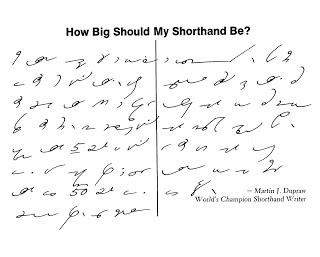Here is some advice by Martin J. Dupraw, a world champion shorthand writer. This little nugget is found in the Gregg-Kit 2 Series 90, pg. 105. The shorthand was written by Jerome P. Edelman.
(Feel free to swap the .jpeg out with the .pdf I sent you, Carlos!)
Key:
Each writer must set his or her own size for shorthand writing. Whatever size seems right to you is probably the best size for you. One skillful shorthand reporter writes 500 words of shorthand on an ordinary notebook page; another writes only 50 words on a similar page. Neither extreme is recommended. But if you naturally find yourself writing very large notes or very small notes, you need not be concerned about it. The size of your notes will have little or no effect on your speed.

Jerry Edelman! I remember having a long phone call with him back about ten years ago. Friendly guy.
How neat! I love Edelman's shorthand. I've always wondered what became of all these Gregg giants.
This particular post is Dupraw's writing actually.
It does look to be Dupraw's style, now that I look at it. That sample appears in many shorthand books, being somehow updated with later versions of Gregg Shorthand. He had a particularly strange penmanship, but it is quite easy to read.
Yes. The original article (much longer, about 3000 words) appeared as an Appendix in the first edition Gregg Dictation Simplified. The shorter extract appeared in the first edition of Gregg Dictation DJS and was rewritten here for the Gregg Dictation and Transcription Series 90 book.
Hmm… I thought I first saw the original article in the Anni Functional Manual.
Are you sure this is Dupraw's writing and not Edelman's? It looks more like Edelman's to me. Dupraw typically rounds his corners and exaggerates long versus short strokes.
It was signed by Dupraw in the Series 90 Dictation book, but now that you say it, in the kit it was not signed by him, so it may be Edelman's writing after all.
Any graphologists on the list, to solve the mystery? Wouldn't that be fun… I wonder if any graphologists have ever tried to analyze shorthand before.
At any rate, I'll have to track down that longer version that Carlos mentioned. I'd love to read more of Dupraw's thoughts on the subject.
Well, now having questioned whether Dupraw wrote this passage, I have to admit that the words "page", "very", and "size" look more like Dupraw than Edelman. I don't have the Series 90 Dictation book at hand, so I can't make a direct comparison. But I've looked at Dupraw's writing of this passage in DJ and Simplified, and I'm basing these remarks on those.
**********
Above I asked whether this first appeared in the Anni FM. It doesn't. But I still think I first read the complete version in Anni, not in Simplified. Am I mistaken, or does it appear in Anni somewhere?
What you mention is what led me to believe it was Dupraw's writing in the first place.
I don't recall the passage in any Anniversary book. All of the passages I've read that were written by M.D. in the Anniversary books were either letters, selections from the Congressional Record, or reporting contest material. But I may be mistaken.
This is part of a longer article by Dupraw that appeared in the first edition of Gregg Dictation Simplified (1949), pages 406-425.
The mystery has been solved, no graphologist needed, :-). I found out, from Mr. Edelman himself, that he actually wrote that particular plate in the adult education kit. For the other plate in the Series 90 Dictation book with Dupraw's signature, it was taken from a note written by Mr. Dupraw in a reporter's notebook and typeset.
Very cool!
But… does size matter?
I have read many opinions of shorthand reporters about this subject and they agree that the shorter the faster. I don't know if this is only valid for other shorthand systems but Gregg.
In my case, I learned Simplified with big strokes, but since I got in Preanniversary, I have written them smaller.
First of all, thanks, Carlos, for solving this mystery.
As for the question by Osvaldo, the old-fashioned idea was that short strokes should be faster because they entailed less writing. Researches conducted in the early 20th century definitively showed that this is not the case. The most comfortable size for the writer is the one that produces the greatest speed. Early Gregg texts had plates that were written large and then photo-reduced for printing. The texts recommended the reduced size as the proper size for writing. But in later texts this dishonesty was corrected and the plates were printed at 100% size.
Because of its use of position writing, Pitman more or less imposes a specific size on the writer. The only way to effectively change the size of the notes in Pitman is to use paper with lines a different distance apart. But Gregg is free of this restriction, and some expert writers who preferred large writing ignored the distance between lines in their steno pads.
You're welcome!
I agree. Further, I don't like small print because it is harder to read.